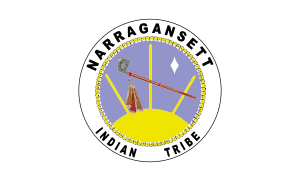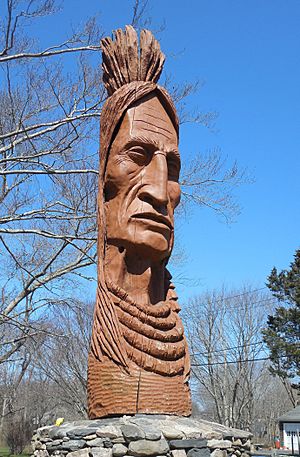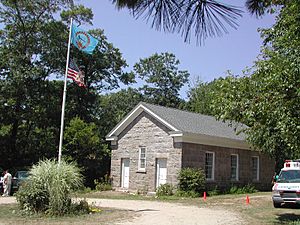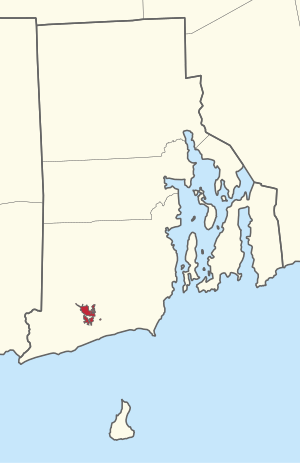Narragansett people facts for kids
 |
|
| Total population | |
|---|---|
| 2,400 (1990s) | |
| Regions with significant populations | |
| United States (Rhode Island) 41°24′34″N 71°40′03″W / 41.40944°N 71.66750°W |
|
| Languages | |
| Formerly Narragansett, now English | |
| Religion | |
| Traditional tribal religion, Christianity |
|
| Related ethnic groups | |
| Nipmuc, Niantic, Pawtuxet, Pequot, Shawomet |
The Narragansett people are an Algonquian Native American tribe from Rhode Island. Today, they are officially known as the Narragansett Indian Tribe. The United States government recognized them as a tribe in 1983.
For most of the 1900s, the tribe had almost no land. In 1991, they bought some land and asked the government to officially hold it for them as part of their Indian reservation. This would have meant the land was under tribal law, not Rhode Island state law. However, in 2009, the U.S. Supreme Court said no. They ruled that tribes recognized after 1934 could not have new lands taken into federal trust and removed from state control.
Contents
Narragansett Tribal Lands
The Narragansett tribe was officially recognized by the U.S. government in 1983. They control the Narragansett Indian Reservation, which is about 1,800 acres (7.3 km²) of land in Charlestown, Rhode Island. A small number of tribal members live on or near this reservation. The tribe also owns several hundred acres in Westerly.
In 1991, the Narragansetts bought 31 acres (125,000 m²) in Charlestown to build homes for older tribal members. In 1998, they asked the government to hold this land in trust for them. This would have taken the land out of state and local control. The state of Rhode Island disagreed, and the case went to the U.S. Supreme Court. Twenty-one other states joined Rhode Island in their appeal.
In 2009, the Supreme Court decided that the government could not take land into trust for tribes recognized after the 1934 Indian Reorganization Act. This rule applied if the land was bought after the tribe gained federal recognition.
How the Narragansett Tribe is Governed
The Narragansett tribe is led by an elected tribal council. They also have a chief sachem (a leader), a medicine man, and a Christian leader. For big decisions, all tribal members must agree.
In 2018, the leaders included:
- Chief Sachem: Anthony Dean Stanton
- Medicine Man: John Babcock Brown
Tribal Council Members
- Cassius Spears, Jr., 1st Councilman
- Mike Monroe Sr, 2nd Councilman
- John Pompey
- Lonny Brown, Sr.
- Yvonne Lamphere
- Keith Sampson
- Shawn Perry
- John Mahoney
- Raymond Lamphere
- Tribal Secretary: Monica Stanton
- Assistant Tribal Secretary: Betty Johnson
- Tribal Treasurer: Mary S. Brown
- Assistant Tribal Treasurer: Walter K. Babcock
Meaning of the Name Narragansett
Some Narragansett people today believe their name means "people of the little points and bays." Another idea is that it means "(People) of the Small Point."
The Narragansett language mostly disappeared in the 1800s. So, to understand old words, people study writings from English colonists in the 1600s. Back then, the name was spelled in many ways. The spelling "Narragansett" was first used by John Winthrop in 1646. Roger Williams, who founded Providence and knew the Narragansett people well, used spellings like "Nanhiggonsick" and "Narriganset."
Linguist James Hammond Trumbull explained that naiag or naiyag means a corner or angle in Algonquian languages. So, the name na-ig-an-set likely means "the territory about the point."
Roger Williams studied the Narragansett language a lot. In 1643, he wrote a book called A Key into the Language of America. He thought the name Narragansett came from a small island. He wrote that he went to see this island, which was between Puttaquomscut and Mishquomacuk, near Sugar Loaf Hill.
William Simmons, an expert on the Narragansett people, also said the name referred to both a place and the people living there. He agreed with Roger Williams that it came from a small island.
In 1987, archaeologists found an ancient Narragansett village near Point Judith Pond. This was close to where Roger Williams said the island was. This site, called Salt Pond Archaeological Site (RI 110), showed a village from about 1100 to 1300 A.D. They found human burials, homes, cooking areas, and tools. This was a very important discovery because it was the first time such a complete Native American coastal village was found in the Northeastern United States.
Narragansett Language
The Narragansett tribe traditionally spoke the Narragansett language. This language is part of the Algonquian languages family. Narragansett was a "Y-dialect," meaning it was similar enough to "N-dialects" like Massachusett and Wampanoag that speakers could understand each other.
The Narragansett language almost died out in the 1900s. However, the tribe is now working to bring it back. They use old books and writings from the early 1900s and have started new teaching programs.
In the 1600s, Roger Williams learned the Narragansett language. He wrote about it in his 1643 book, A Key into the Language of America. In this book, he spelled the tribe's name Nanhigganeuck.
Many words in American English actually come from Narragansett and other related languages. Some examples include quahog, moose, papoose, powwow, squash, and succotash.
Narragansett History
The Narragansetts were one of the most important tribes in New England. They controlled the western side of Narragansett Bay in Rhode Island. Their land also reached into parts of Connecticut and eastern Massachusetts.
The first time Europeans met the Narragansetts was in 1524. This was when explorer Giovanni de Verrazzano visited Narragansett Bay.
Between 1616 and 1619, many Native Americans in coastal areas south of Rhode Island died from diseases. The Narragansetts were not affected by these sicknesses. When English colonists arrived in 1620, the Narragansetts were the most powerful tribe in the southern New England area.
Chief Massasoit of the Wampanoag tribe, who lived to the east, made an alliance with the colonists at Plymouth Colony. This was to protect his people from Narragansett attacks. In 1621, the Narragansetts sent a bundle of arrows wrapped in snakeskin to Plymouth. This was a challenge. But Governor William Bradford sent the snakeskin back filled with gunpowder and bullets. The Narragansetts understood the message and did not attack.
Europeans did not start settling in Narragansett territory until 1635. In 1636, Roger Williams bought land from Narragansett leaders Canonicus and Miantonomi. He then started the settlement of Providence Plantations.
Pequot War and Conflicts
During the Pequot War in 1637, the Narragansetts fought alongside the English colonists. However, the colonists' extreme violence in the Mystic massacre shocked the Narragansetts, and they left. After the Pequots were defeated, the colonists gave some captured Pequots to their allies, the Narragansetts and the Mohegans.
Later, the Narragansetts and Mohegans fought over control of the land taken from the Pequots. In 1643, Miantonomoh led about 1,000 Narragansett warriors to attack the Mohegans. But the Narragansett forces broke apart, and Miantonomoh was captured and killed. The next year, Narragansett war leader Pessicus started the war with the Mohegans again.
The Mohegans were almost defeated. But the colonists sent troops to help them. The colonists then threatened to invade Narragansett land. So, Canonicus and his son Mixanno signed a peace treaty. This peace lasted for the next 30 years.
King Philip's War
Christian missionaries began trying to convert Native Americans. Many Native Americans worried they would lose their traditions. In 1675, John Sassamon, a Christian Native American, was found dead. Some believe Wampanoag leader Metacomet (also known as Philip) ordered his death. Three Wampanoag men were arrested and executed for it.
Metacomet then declared war on the colonists. This started King Philip's War. The fighting spread across Massachusetts. Other tribes, like the Nipmuc, joined in. The Native Americans wanted to force the colonists out of New England. They attacked settlements in Massachusetts and Connecticut. Rhode Island was safe at first because the Narragansetts stayed neutral.
However, the leaders of the United Colonies (Massachusetts, Plymouth, and Connecticut) accused the Narragansetts of hiding Wampanoag refugees. So, on December 19, 1675, they attacked the Narragansett fort in a battle called the Great Swamp Fight. Hundreds of Narragansett non-fighters, including women and children, died when the fort was burned. But most of the warriors escaped.
In January 1676, the Native Americans fought back. They destroyed all colonial settlements on the western side of Narragansett Bay. Providence Plantations was burned on March 27, 1676. Many towns across New England were destroyed. But by the end of March, the Native American effort weakened due to disease, hunger, battle losses, and lack of gunpowder.
Troops from Connecticut, including colonists and their Mohegan allies, attacked the weakened Narragansetts in Rhode Island. They killed many. Narragansett leader Canonchet was captured and killed. Metacomet was also hunted down and killed. This ended the war in southern New England.
After the war, some surviving Narragansetts were sold into slavery and sent to the Caribbean. Others became servants in Rhode Island. The remaining Narragansetts joined with other local tribes, especially the Eastern Niantics. Over time, tribal members married colonists and Africans. Their families were accepted into the tribe, which helped the Narragansetts keep their tribal and cultural identity.
1700s and 1800s: Keeping Identity
Ninigret, the Narragansett chief during King Philip's War, died soon after. His children and grandchildren continued to lead the tribe. During the 1700s, much of the Narragansett land was sold. Many tribal members moved to New York to join other Algonquian-speaking Native Americans.
However, in the 1740s, colonists started the Narragansett Indian Church. The tribe kept control of this church and its 3 acres (12,000 m²) of land. This continuous ownership was very important. It showed that the tribe had always existed when they asked for federal recognition in 1983.
In the 1800s, the state tried to say the Narragansetts were no longer a tribe because many members had mixed ancestry. But the tribe argued that they had always welcomed other people into their tribe through marriage. They said these people became culturally Narragansett.
The tribal leaders also resisted pressure after the American Civil War to become U.S. citizens. This would have meant giving up their treaty rights and their status as an Indian nation. The Narragansetts saw themselves as "a nation rather than a race." They insisted on their rights as an Indian nation.
In 1876, a Narragansett group told state lawmakers that they saw unfairness for Black people under Jim Crow laws, even though they were citizens. They said: "We are not negroes, we are the heirs of Ninagrit, and of the great chiefs and warriors of the Narragansetts. Because, when your ancestors stole the negro from Africa and brought him amongst us and made a slave of him, we extended him the hand of friendship, and permitted his blood to be mingled with ours, are we to be called negroes? And to be told that we may be made negro citizens? We claim that while one drop of Indian blood remains in our veins, we are entitled to the rights and privileges guaranteed by your ancestors to ours by solemn treaty, which without a breach of faith you cannot violate."
From 1880 to 1884, the state continued trying to end the tribe's official status. The tribe agreed to sell some land but quickly regretted it. The state sold tribal lands to the public. But the tribe did not disappear. Its members continued to practice their culture.
1900s and 2000s: Regaining Recognition
Even though they lost much of their land in the late 1800s, the Narragansetts kept their group identity. The tribe officially formed a corporation in 1900. In 1940, they built their longhouse as a traditional place for meetings and ceremonies.
In the late 1900s, they worked to control their future. They got back 1,800 acres (7.3 km²) of their land in 1978. In 1983, they gained federal recognition as a tribe. Today, there are about 2,400 members of the Narragansett Tribe. Like most Americans, they have mixed ancestry, including Narragansett, other New England tribes, Europeans, and Africans.
In 2006, archaeologists found remains of a Narragansett village from 1100 to 1300 A.D. near Point Judith Pond. This area was known to be historically important. The state stopped a building project to buy the 25-acre site for preservation.
Further digs showed it was one of only two pre-Columbian villages on the Atlantic Coast found in such good condition. The other is in Virginia. This site had many permanent structures. Archaeologists found evidence of 22 structures, three human burial sites, granaries, and cooking pits. This discovery showed how important corn farming was to these tribes. Before this, historians knew Algonquian tribes grew corn, but they had no physical proof. In the first week of digging, 78 corn kernels were found. This was the first time corn cultivation was confirmed this far north on the Atlantic Coast.
Current Narragansett tribal members have shared oral histories about the ancient people who lived at this site. They were part of the Turtle Clan. The settlement was a place for trading medicines. They used the nearby pond and islands for hunting, fishing, gathering shellfish, burials, and collecting herbs for medicine and ceremonies.
Roger Williams was taken to Sugarloaf Hill by the Narragansett tribe. They pointed to this large settlement and called it Nanihigonset. This site is now believed to be the heart of Narragansett land, where the tribe first came together and grew its influence.
Land Claim and Federal Recognition
In 1975, the Narragansett Tribe sued the federal government. They wanted to get back 3,200 acres (13 km²) of land in southern Rhode Island. They said the state had taken it illegally in 1880.
In 1978, the Narragansett Tribe, Rhode Island, and the Town of Charlestown signed an agreement. The state gave 1,800 acres (7.3 km²) to a group that would hold the land for the descendants of the 1880 Narragansett Roll. In return, the tribe agreed that Rhode Island laws would apply on these lands, except for hunting and fishing. At this time, the Narragansetts were not yet federally recognized.
In 1979, the tribe applied for federal recognition. They provided many documents proving their family history and their continuous existence as a tribe. In 1983, they were officially recognized as the Narragansett Indian Tribe of Rhode Island.
Current Events and Challenges
The state and the tribe have had disagreements. In 2003, Rhode Island state police raided a tribe-run smoke shop on the reservation. This was because the tribe did not pay state taxes on cigarette sales. In 2005, a court said the police action violated the tribe's independence. But in 2006, a different court decision said the raid was okay because of the 1978 land agreement.
The tribe also sued the police for using too much force during the 2003 raid. One Narragansett man broke his leg. This case was re-tried in 2008.
The Narragansett Tribe has been talking with the state government about building a casino in Rhode Island. Their partner is currently Harrah's Entertainment. However, Rhode Island's constitution says that only state-run gambling is allowed. In 2006, people in the state voted against a change to the constitution that would have allowed the casino.
The tribe plans to improve their Longhouse, built in 1940. They want it to be a place for Native American food and cultural meetings. They also plan to upgrade their medical, technology, and art systems.
Like many tribes, the Narragansetts have been reviewing their tribal membership. They now require members to show direct family ties to one or more of the 324 members listed on the 1880-84 Roll. The tribe has closed its membership rolls. They have removed some people and denied new applications. This is a trend among tribes, sometimes due to family disagreements or new money from casinos. Some people who were removed later formed the unrecognized Northern Narragansett Tribe.
In 2008, the U.S. Supreme Court agreed to hear the case Carcieri v. Salazar. This case was about Native American land rights. In February 2009, the Court ruled in favor of Rhode Island. The state had sued the Department of the Interior (DOI) over its power to take land into trust for certain Native Americans.
The state argued that the 1934 Indian Reorganization Act did not apply to tribes recognized after 1934. The Supreme Court agreed with the state. This ruling affected 31 acres (125,000 m²) in Charlestown that the Narragansetts bought in 1991. The tribe wanted the DOI to take this land into trust to remove it from state control.
Cultural Institutions and Events
The Narragansett tribe holds its annual powwow on the second weekend of August. It takes place on their reservation in Charlestown, Rhode Island. This gathering is a time of thanksgiving and honor for the Narragansett people. It is the oldest recorded powwow in North America, with colonial records dating back to 1675. The powwow was held long before Europeans arrived.
In August 2017, the tribe held its 342nd powwow. Events included the traditional grand entry, where military veterans, dancers, and tribal representatives march in. There was also a ceremonial lighting of a sacred fire, a church service, food, and arts and crafts.
Notable Narragansett People

Here are some well-known Narragansett individuals:
- Ellison "Tarzan" Brown (1913–1975), a runner who won the Boston Marathon twice (1936, 1939) and was in the 1936 U.S. Olympics.
- Tiffany Cobb (born 1976), an R&B singer with Narragansett and other ancestries.
- Sonny Dove (1945–1983), a basketball player.
- George Fayerweather (1802–1869), a blacksmith who hosted anti-slavery activists. His wife, Sarah Harris Fayerweather, was very active in the movement.
- Robyn E. Hannigan, a scientist and provost at Clarkson University, whose mother is Narragansett.
- John Christian Hopkins (born 1960), a journalist and author.
- Nancy Elizabeth Prophet (1890–1960), a sculptor of African-Narragansett descent.
- Princess Red Wing (1896–1987), a historian, museum curator, and Squaw Sachem.
- Ella Sekatau (1928-2014), a poet, historian, and Medicine Woman.
- Russell Spears (1917–2009), a stonemason.
- Loren Spears, an educator and writer.
- Rev. Harold Mars, a preacher and prophet.
List of Narragansett Sachems (Leaders)
| Name | Years of Leadership | Family Connection | Notes |
|---|---|---|---|
| Tashtassuck | Historical information is not certain | ||
| Wessoum | Descendant of Tashtassuck | Mentioned by Uncas as an ancestor | |
| Canonicus | 1600s to 1636 | Grandson or Son of Wessoum | First time as a famous chief |
| Miantonomo | 1636 to 1643 | Nephew of Canonicus | |
| Canonicus | 1643 to 1647 | Uncle of Miantonomo | Second time as chief |
| Mriksah | 1647 to 1667 | Son of Canonicus | |
| Canonchet | 1667 to 1676 | Son of Miantonomo, Great-cousin of Mriksah | |
| Ninigret | 1676 to 1682? | Chief during King Philip's War | |
| Weunquesh | ? | Daughter of Ninigret | |
| Ninigret II | ? - 1722 | Son of Ninigret I, half-brother of his predecessor | His painting is at the RISD museum |
| Charles Augustus | 1722 - ? | Eldest son of Ninigret II | |
| George | ? | Second son of Ninigret II | |
| Thomas | ? - 1746 | Son of George | Known as "King Tom" |
See also
 In Spanish: Narragansett para niños
In Spanish: Narragansett para niños





